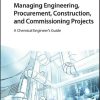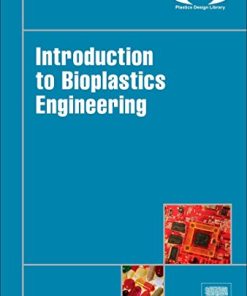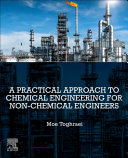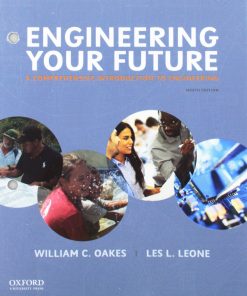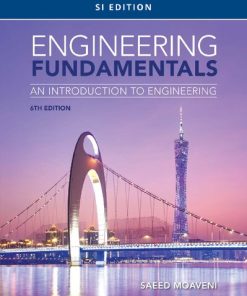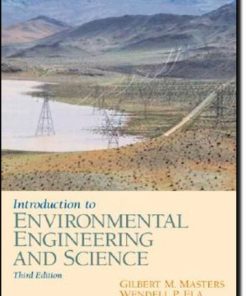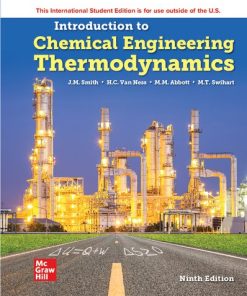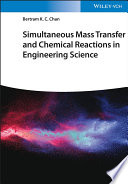(Ebook PDF) Introduction to Chemical Engineering 1st edition by Van Land 1119634121 9781119634126 full chapters
$50.00 Original price was: $50.00.$25.00Current price is: $25.00.
Introduction to Chemical Engineering 1st edition by C. M. Van ‘T Land – Ebook PDF Instant Download/DeliveryISBN: 1119634121, 9781119634126
Full download Introduction to Chemical Engineering 1st edition after payment.
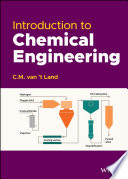
Product details:
ISBN-10 : 1119634121
ISBN-13 : 9781119634126
Author: C. M. Van ‘T Land
Chemical engineering plays a vital role in numerous industries, including chemical manufacturing, oil and gas refining and processing, food processing, biofuels, pharmaceutical manufacturing, plastics production and use, and new energy recovery and generation technologies. Many people working in these fields, however, are nonspecialists: management, other kinds of engineers (mechanical, civil, electrical, software, computer, safety, etc.), and scientists of all varieties. Introduction to Chemical Engineering is an ideal resource for those looking to fill the gaps in their education so that they can fully engage with matters relating to chemical engineering.
Introduction to Chemical Engineering 1st Table of contents:
1. A Typical Chemical Production System
2. Chemical Reactors and Unit Operations
References
Part I: Transport Phenomena
1 Mass Balances
1.1 Introduction
1.2 Theory
1.3 Additional Material
Reference
2 Energy Balances
2.1 Definitions
2.2 The General Energy Balance
2.3 Applications of the General Energy Balance
2.4 The Mechanical Energy Equation
2.5 Applications of the Mechanical Energy Balance
References
3 Viscosity
3.1 Definition
3.2 Newtonian Fluids
3.3 Non‐Newtonian Fluids
3.4 Viscoelasticity
3.5 Viscosity of Newtonian Fluids
References
4 Laminar Flow
4.1 Steady‐state Flow Through a Circular Tube
4.2 Rotational Viscosimeters
4.3 Additional Remarks
5 Turbulent Flow
5.1 Velocity Distribution
5.2 The Reynolds Number
5.3 Pressure Drop in Horizontal Conduits
5.4 Pressure Drop in Tube Systems
5.5 Flow Around Obstacles
5.6 Terminal Velocity of a Swarm of Particles
5.7 Flow Resistance of Heat Exchangers with Tubes
References
6 Flow Meters
6.1 Introduction
6.2 Fluid-energy Activated Flow Meters
6.3 External Stimulus Flow Meters
References
7 Case Studies Flow Phenomena
7.1 Energy Consumption: Calculation of the Power Potential of a High Artificial Lake
7.2 Estimation of the Size of a Pump Motor
8 Heat Conduction
8.1 Introduction
8.2 Thermal Conductivity
8.3 Steady‐state Heat Conduction
8.4 Heating or Cooling of a Solid Body
References
9 Convective Heat Transfer
9.1 Heat Exchangers
9.2 Heat Transfer Correlations
References
10 Heat Transfer by Radiation
10.1 Introduction
10.2 IR
10.3 Dielectric Heating
References
11 Case Studies Heat Transfer
11.1 Bulk Materials Heat Exchanger
11.2 Heat Exchanger
11.3 Surface Temperature of the Sun
11.4 Gas IR Textile Drying
11.5 Heat Loss by IR Radiation
11.6 Microwave Drying of a Pharmaceutical Product
References
12 Steady‐state Diffusion
12.1 Introduction and Definition of the Diffusion Coefficient
12.2 The Diffusion Coefficient
12.3 Steady‐state Diffusion
References
13 Convective Mass Transfer
13.1 Partial and Overall Mass Transfer Coefficients
13.2 Mass Transfer Between a Fixed Wall and a Flowing Medium
13.3 Simultaneous Heat and Mass Transfer at Convective Drying
References
14 Case Studies Mass Transfer
14.1 Equimolar Diffusion
14.2 Diffusion through a Stagnant Body
14.3 Sublimation of a Naphthalene Sphere
Reference
Notation I
Greek Symbols
Part II: Mixing and Stirring
15 Introduction to Mixing and Stirrer Types
References
16 Mixing Time
16.1 Introduction
16.2 Approach of Beek et al.
16.3 Approach of Zlokarnik
References
17 Power Consumption
References
18 Suspensions
18.1 Introduction
18.2 Power Consumption
18.3 Further Work
References
19 Liquid/Liquid Dispersions
Reference
20 Gas Distribution
20.1 Introduction
20.2 Turbine
20.3 Pitched‐Blade Turbine Pumping Downward
20.4 Turbine Scale Up
20.5 Batch Air Oxidation of a Hydrocarbon
20.6 Remark
Appendix 20.1
References
21 Physical Gas Absorption
21.1 Introduction
21.2 kl ⋅ a Measurements
21.3 Power Consumption on Scaling Up
21.4 Remarks
References
22 Heat Transfer in Stirred Vessels
22.1 Introduction
22.2 Heat Transfer Jacket Wall/Process Liquid
22.3 Heat Transfer Coil Wall/Process Liquid
22.4 Heat Transfer Jacket Medium/Vessel Wall
22.5 Heat Transfer Coil Medium/Coil Wall
22.6 Batch Heating and Cooling
References
23 Scale Up of Mixing
23.1 Introduction
23.2 Homogenization
23.3 Suspensions
23.4 Liquid/Liquid Dispersions
23.5 Gas Distribution
23.6 kl ⋅ a
23.7 Heat Transfer
References
24 Case Studies Mixing and Stirring
24.1 Mixing Time—Comparison of Stirrers
24.2 Mixing Time–Scale Up of Process
24.3 Suspensions
24.4 Air Oxidation Optimization
24.5 Calculating kl ⋅ a
24.6 Heating Toluene in a Stirred Vessel
24.7 Overall Heat Transfer Coefficient of a Jacketed Reactor
24.8 Scale Up of Mixing
References
Notation II
Greek Symbols
Part III: Chemical Reactors
25 Chemical Reaction Engineering—An Introduction
25.1 Fluidized Catalytic Cracking (FCC)
25.2 Kinetic Rate Data and Transport Phenomena
25.3 Reactor Types
25.4 Batch Reactions Versus Continuous Reactions
25.5 Adiabatic Temperature Rise
25.6 Recycle
25.7 Process Intensification
References
26 A Few Typical Chemical Reactors
26.1 The Carbo‐V‐Process of Choren
26.2 Coal Gasification
26.3 Biofuels
26.4 Pyrogenic Silica
26.5 Microwaves
27 The Order of a Reaction
27.1 The Rate of a Reaction
27.2 Introductory Remarks on the Order of a Reaction
27.3 First‐Order Reaction
27.4 Second‐Order Reactions
References
28 The Rate of Chemical Reactions as a Function of Temperature
28.1 Arrhenius’ Law
28.2 How to Influence Chemical Reaction Rates
Reference
29 Chemical Reaction Engineering—A Quantitative Approach
29.1 Introduction
29.2 Batch Reactor
29.3 Plug Flow Reactor
29.4 Continuous Stirred Tank Reactor (CSTR)
29.5 Reactor Choice
29.6 Staging
29.7 Reversible Reactions
30 A Plant Modification: From Batchwise to Continuous Manufacture
30.1 Introduction
30.2 Batchwise Production
30.3 Continuous Manufacture
Reference
31 Intrinsic Continuous Process Safeguarding
31.1 Summary
31.2 Introduction
31.3 The Production of Organic Peroxides
31.4 Intrinsically Safe Processes
31.5 Intrinsic Process Safeguarding
31.6 Extrinsic Process Safeguarding
31.7 Additional Remarks
31.8 Practical Approach
31.9 Examples
References
32 Reactor Choice and Scale Up
32.1 Introduction
32.2 Parallel Reactions
32.3 Physical Effects
33 Case Studies Chemical Reaction Engineering
33.1 Order of a Reaction
33.2 Chemical Reaction Rate as a Function of Temperature
33.3 Reactor Size
33.4 Reversible Reactions
33.5 Competing Reactions
33.6 The Hydrolysis of Acetic Acid Anhydride
33.7 Cumene Air Oxidation
References
Notation III
Greek Symbols
Part IV: Distillation
34 Continuous Distillation
34.1 Introduction
34.2 Vapor–Liquid Equilibrium
34.3 The Fractionating Column
34.4 The Number of Trays Required
34.5 The Importance of the Reflux Ratio
34.6 A Typical Continuous Industrial Distillation
References
35 Design of Continuous Distillation Columns
35.1 Sieve Tray Columns
35.2 Packed Columns
Note
References
36 Various Types of Distillation
36.1 Batch Distillation
36.2 Azeotropic and Extractive Distillation
36.3 Steam Distillation
References
37 Case Studies Distillation
37.1 McCabe–Thiele Diagram
37.2 Diameter of a Sieve Tray Column and Sieve Tray Pressure Loss
37.3 The Distillation of Wine
37.4 Steam Distillation
Reference
Notation IV
Greek Symbols
Part V: Liquid Extraction
38 Liquid Extraction – Part 1
38.1 Introduction
38.2 The Distribution Coefficient
38.3 Calculation of the Number of Theoretical Stages in Extraction Operations
References
39 Liquid Extraction – Part 2
39.1 Calculation of the Number of Transfer Units in Extraction Operations
Reference
40 Flooding
40.1 General
References
41 The Two Liquids Exchanging a Component Are Partially Miscible
41.1 Triangular Coordinates
41.2 Formation of One Pair of Partially Miscible Liquids
41.3 Continuous Countercurrent Multiple‐contact Extraction
References
42 Case Studies Liquid Extraction
42.1 A Series of Centrifugal Extractors
42.2 Extraction by Means of An Ionic Liquid
42.3 Overall Transfer Coefficient/Height of a Transfer Unit
42.4 Calculation of the Column Height
42.5 Two Partially Miscible Liquids Exchange a Component
References
Notation V
Greek Symbols
Part VI: Absorption of Gases
43 Absorption of Gases
43.1 Introduction
43.2 Determination of the Number of Theoretical Stages at Absorption of Gases
43.3 Estimation of the Diameter of an Absorption Column for Natural Gas
43.4 The Absorption of Carbon Dioxide
43.5 Design of Absorption Columns
References
Notation VI
Greek Symbols
Part VII: Membranes
44 Membranes—An Introduction
44.1 General
44.2 Membranes
44.3 Three Pressure‐Driven Membrane Separation Processes for Aqueous Systems
44.4 A Membrane Separation Process for Aqueous Solutions Which Is Driven by an Electrical Potential Difference
44.5 Gas Separation
44.6 Pervaporation
44.7 Medical Applications
44.8 Additional Remarks
References
45 Microfiltration
45.1 Introduction
45.2 Membrane Types
45.3 Membrane Characterization
45.4 Filter Construction
45.5 Operational Practice
References
46 Ultrafiltration
46.1 Introduction
46.2 Membrane Characterization
46.3 Concentration Polarization and Membrane Fouling
46.4 Membrane Cleaning
46.5 Ultrafiltration Membrane Systems
46.6 Continuous Systems
46.7 Applications
References
47 Reverse Osmosis
47.1 Osmosis
47.2 Reverse Osmosis
47.3 Theoretical Background
47.4 Concentration Polarization
47.5 Membrane Specifications
47.6 Membrane Qualities
47.7 Reverse Osmosis Units
47.8 Membrane Fouling Control and Cleaning
47.9 Applications
47.10 Nanofiltration Membranes
47.11 Conclusions and Future Directions
References
48 Electrodialysis
48.1 Introduction
48.2 Functioning of Ion‐Exchange Membranes
48.3 Types of Ion Exchange Membranes
48.4 Transport in Electrodialysis Membranes
48.5 Power Consumption
48.6 System Design
48.7 Applications
References
49 Gas Separation
49.1 Introduction
49.2 Theoretical Background
49.3 Process Design
49.4 Applications
References
50 Case Studies Membranes
50.1 Gel Formation
50.2 Osmotic Pressure
50.3 Membrane Gas Separation
References
Notation VII
Greek Symbols
Part VIII: Crystallization, Liquid/Solid Separation, and Drying
51 Crystallization
51.1 Introduction
51.2 Solubility
51.3 Nucleation
51.4 Crystal Growth
51.5 Crystallizers and Crystallizer Operations
51.6 The Population Density Balance
51.7 Interpretation of the Results of Population Density Balances
References
52 Liquid/Solid Separation
52.1 Introduction
52.2 Filtration
52.3 Centrifugation
Reference
53 Convective Drying
53.1 Introduction
53.2 Four Important Continuous Convective Dryers in the Chemical Industry
53.3 A First Example of Convective Drying
53.4 The Adiabatic Saturation Temperature
53.5 The Wet‐Bulb Temperature
53.6 The Mollier Diagram
53.7 Drying Vacuum Pan Salt in a Plug Flow Fluid‐Bed Dryer
54 Design of a Flash Dryer
54.1 Introduction
54.2 Design
Reference
55 Contact Drying
55.1 Introduction
55.2 Scaling Up of a Conical Vacuum Dryer
55.3 An Additional Remark Concerning Vacuum Drying
55.4 Testing a Small Plate Dryer
55.5 Testing a Continuous Paddle Dryer
55.6 Scale Up of a Thin‐Film Dryer
Reference
56 Case Studies Crystallization, Liquid/Solid Separation, and Drying
56.1 Ultracentrifuges
56.2 Le2/3
56.3 Convective Drying‐1
56.4 Convective Drying‐2
56.5 Analysis of a Spray‐Drying Operation
56.6 Estimation of the Size of a Contact Dryer
References
Notation VIII
Greek Symbols
Part IX: Gas/Solid Separation
57 Introduction
58 Cyclones
58.1 Introduction
58.2 Sizing and Process Data
References
59 Fabric Filters
59.1 Introduction
59.2 Fabrics
59.3 Baghouse Construction and Operation
Reference
60 Scrubbers
60.1 Introduction
60.2 Packed‐Bed Scrubbers
60.3 Venturi Scrubbers
60.4 Mechanical Scrubbers
References
61 Electrostatic Precipitators
61.1 Introduction
61.2 Principle of Operation
61.3 Process Data
61.4 Construction
People also search for Introduction to Chemical Engineering 1st:
introduction to chemical engineering analysis
introduction to chemical engineering and computer calculations
introduction to chemical engineering analysis pdf
introduction to chemical engineering and thermodynamics
introduction to chemical engineering analysis russell pdf
Tags:
Introduction,Chemical Engineering,Van Land
You may also like…
Engineering - Chemical Engineering
A Practical Approach to Chemical Engineering for Non-Chemical Engineers 1st Edition Moe Toghraei
Engineering
Engineering Your Future: A Comprehensive Introduction to Engineering 9th Edition William C. Oakes
Engineering - Chemical Engineering
Introduction to Chemical Engineering Thermodynamics J M Smith



